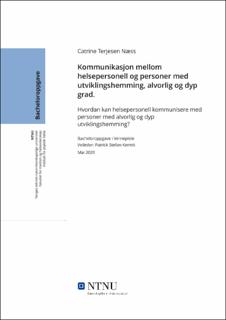| dc.description.abstract | Sammendrag
Tittel: Kommunikasjon mellom helsepersonell og personer med utviklingshemming, alvorlig og dyp grad.
Nøkkelord: Alvorlig utviklingshemming, dyp utviklingshemming, helsepersonell, kommunikasjon, samspill.
Introduksjon: Alle mennesker kan kommunisere, så lenge de får muligheten. For personer med alvorlig og dyp utviklingshemming er det nærpersonen som avgjør hvor god denne muligheten er (Horgen, 2006). Som helsepersonell og fagpersoner opplever vi andre kommunikasjonsutfordringer enn de vi ofte møter i hverdagslivet, og dette krever kompetanse og engasjement (Røkenes & Hanssen, 2012).
Hensikt: Intensjonen med denne litteraturstudien er å avdekke hvordan helsepersonell og personer med alvorlig og dyp utviklingshemming kan kommunisere på en god måte.
Metode: Det er benyttet litteraturstudie i denne bacheloroppgaven. Seks vitenskapelige forskningsartikler er inkludert.
Resultater: Basert på funnene fra inkluderte artikler ble det identifisert betydningsfulle faktorer som støtter opp og bidrar til god kommunikasjon mellom helsepersonell og personer med alvorlig og dyp utviklingshemming. Studien resulterte i tre temaer:
1. Helsepersonellet må se individet og bruke analyse og individuelle tilpasninger for å kommunisere.
2. Helsepersonellet må kommunisere slik at brukeren har mulighet til å forstå og være delaktig.
3. Helsepersonellet må ha fokus i samhandlingen og prioritere kommunikasjon i hverdagen og være faglig oppdatert.
Konklusjon: Helsepersonell bør kommunisere med personer med alvorlig og dyp utviklingshemming ved å benytte og kopiere uttrykksmåtene brukeren selv har valgt. I kommunikasjonen må helsepersonellet gi brukeren god tid til å gi respons, og fokuset til helsepersonellet må være på brukeren for å klare å fange opp uttrykk og kommunikasjonsforsøk. | |
| dc.description.abstract | Abstract
Title: Communication between healthcare support workers and people with severe, and profound intellectual disability.
Keywords: Communication, severe intellectual disability, profound intellectual disability, healthcare providers, healthcare support workers , interaction.
Background: Everyone can communicate, given the opportunity. For people with severe, and profound intellectual disabilities, it is the the person, or people, close to them that determines how well this opportunity is exploited (Horgen, 2006). When we work in healthcare, we experience communication challenges different to those we often encounter in everyday life, which require expertise and commitment (Røkenes & Hanssen, 2012).
Purpose: The purpose of this study was to explore/discover how healthcare support workers and people with severe, and profound intellectual disability can communicate well.
Method: A literature study has been used, and six published articles has been included in this bachelor thesis.
Results: Based on the findings from the included articles, significant factors were identified which support and are conductive to good communication between healthcare support workers and people with severe, and profound intellectual disabilities. The study resulted in three themes:
1. Support workers must see the individual, use analysis, and make individual adjustments to communicate.
2. The support workers must communicate so that people with severe, and profound intellectual disabilities can understand and participate.
3. Support workers must focus on the interaction and prioritize communication in everyday life and stay professionally updated.
Conclusion: Healthcare support workers should communicate with people with severe, and profound disabilities by using expressions chosen by the care receiver. In communication the support workers must give the care receiver time to respond, and the focus must be on the person with severe or profound disabilities. In that way the support workers will be able to capture expressions and communication attempts. | |
